
Guests
- Julian Brave NoiseCatwriter, journalist and Oscar-nominated filmmaker.
Watch Part 2 of our interview with award-winning writer, journalist and Oscar-nominated filmmaker Julian Brave NoiseCat as he discusses his debut book, We Survived the Night, and much more. The book weaves together his family’s stories of survival with personal memories, Indigenous oral histories and legends, and on-the-ground reporting that lay bare the resilience of Indigenous peoples across the continent in the face of centuries of colonial genocide. We spoke on Indigenous Peoples’ Day, and NoiseCat also discusses the importance of having “our legacy, our history recognized on our land.” He also responds to Defense Secretary Hegseth’s announcement that 20 Medal of Honor recipients from the 1890 Battle of Wounded Knee massacre will keep their awards. “This is a really tragic moment in United States history,” NoiceCat says. “I think that everybody would recognize that killing 300 men women, and children is not something to be celebrated.”
Transcript
AMY GOODMAN: This is Democracy Now!, democracynow.org, The War and Peace Report. I’m Amy Goodman.
President Trump last week signed a proclamation declaring today to be Columbus Day, saying it should honor Columbus’s, quote, “extraordinary legacy of faith, perseverance, and virtue,” unquote. Perhaps this was in response to more than a dozen states and more than 200 cities around the country celebrating today as Indigenous Peoples’ Day.
We turn now to Part 2 of our interview with Julian Brave NoiseCat, the award-winning writer, journalist, the Oscar-nominated filmmaker for the film Sugarcane, who is just about to publish his debut book titled We Survived the Night.
I thank you so much for staying with us. In Part 1, we talked about your title, We Survived the Night and some of your family’s stories. But I want to start off in Part 2 with your response to President Trump feeling that he has to reassert Columbus Day, when so many cities and states are starting to say, “No, we must call this Indigenous Peoples’ Day.” Talk about that whole movement and what it meant and what he’s doing.
JULIAN BRAVE NOISECAT: Well, you know, for many decades, Indigenous peoples have been working to have our legacy, our history recognized on our land. And the least that could be done is that one out of the 365 days in the calendar year recognize that this is, you know, our continent first.
And, you know, it’s worth pointing out that Columbus is perhaps not the best guy to be be celebrating. You know, he got lost. He thought he was headed to India, and you know, he proceeded to begin a genocide of a people that spanned a continent for hundreds of years. He talked about how the Indigenous peoples who he encountered were, you know, fit for slavery, how they could be easily sort of killed, in the face of, you know, white colonization. And I’m just not so sure that most people, if they encountered those facts, would potentially really want to be celebrating this guy. So, I mean, I don’t know. I mean, it’s just another example to me of the absurdity of this moment.
AMY GOODMAN: Well, I want to talk more about this moment. Defense Secretary Hegseth said, in a video posted on social media recently, the 20 Medal of Honor recipients from the 1890 Battle of Wounded Knee will keep their awards.
DEFENSE SECRETARY PETE HEGSETH: Under my direction, we’re making it clear, without hesitation, that the soldiers who fought in the Battle of Wounded Knee in 1890 will keep their medals. And we’re making it clear that they deserve those medals. This decision is now final, and their place in our nation’s history is no longer up for debate.
AMY GOODMAN: Well, Native American leaders are condemning Hegseth’s move for the Pentagon to preserve these 20 Medals of Honor awarded to the soldiers involved in this 1890 massacre, the Battle of Wounded Knee. On December 29th, 1890, the U.S. Army killed as many as 300 Oglala Lakota people at Wounded Knee, including many women and children. In a statement, National Congress of American Indians Executive Director Larry Wright Jr. said, “Celebrating war crimes is not patriotic. This decision undermines truth-telling, reconciliation, and the healing that Indian Country and the United States still need,” he said. So, Julian Brave NoiseCat, can you respond to what Hegseth has done?
JULIAN BRAVE NOISECAT: So, in 1890, there was a movement sweeping across not just Lakota country in what is now South and North Dakota, but across Indian Country, called the Ghost Dance. It was a millenarian movement that said that if we participated in the Ghost Dance faith, our people’s way of life would come back, and the colonists would disappear. It was a very appealing set of ideas in a moment of apocalyptic death and loss for Native people all across the continent.
And just as an aside, that set of beliefs actually is one that had origins among my people, among others, on the northwestern plateaus. It’s something that I write about in We Survived the Night.
But this idea, particularly in South Dakota, where there was a history of war between the Lakota people and the United States, provoked real unrest among the settlers of the region, including the guy who wrote The Wizard of Oz, by the way. He wrote an editorial at the time in the Aberdeen paper calling for Native people to be massacred because of this.
And it did end up coming to fruition, that in 1890, right around Christmas, around 300 Lakota people were gunned down by the 7th Cavalry. And their corpses were left in the field for about a week before they could be — their frozen bodies could be gathered up and interred in a mass grave. And if you go to the Pine Ridge Reservation in South Dakota, if you go to Wounded Knee, you can actually go and visit that mass grave. It’s on the top of a little hill there. I went and saw it myself.
You know, this is a really tragic moment in United States history. I think that everybody would recognize that killing 300 men, women and children is not something to be celebrated. And yet, there were 20 Medals of Honor awarded at Wounded Knee. And I just think that it is a real sort of marker of where we are at as a country that even this moment of, you know, history that should be condemned by everybody is now being celebrated, and the Medals of Honor are going to remain for the soldiers who committed these atrocities.
AMY GOODMAN: You cover issues like these all the time as a journalist. Talk about how you came to be a writer, and, of course, now not only a journalist, but you’re an Oscar-nominated director, co-director of a story that deeply involves your own family, Sugarcane, and now the author of this magnificent memoir, We Survived the Night.
JULIAN BRAVE NOISECAT: Well, you know, being the child of two worlds, I always was trying to understand the context and the family and the culture that my father came from and that, you know, he left me with to try to figure out a bit more on my own. And one of the major ways that I did that was always through reading and writing.
From a very young age, my mom put Sherman Alexie’s books in my hands. I remember when I was about 11 or 12, I wrote some Sherman Alexie fan fiction, where I, like, tried to write a short story in his style. And, you know, I think I also grew up in a place, Oakland, California, that really encouraged me to, you know, speak out and have a voice. There’s a long history of people cutting against the grain, perhaps, of the dominant culture in the United States coming out of Oakland, California — the Black Panther Party, the United Farm Workers, the Indians of all tribes who occupied Alcatraz in 1969. And —
AMY GOODMAN: Explain what happened in 1969.
JULIAN BRAVE NOISECAT: So, in 1969, it’s actually one of the most significant, overlooked chapters in, probably, civil rights history in this country. A group of Native activists, most of them students, decided that they were going to retake Alcatraz Island, then the deserted former federal prison, under a little-known provision of the Treaty of Fort Laramie, and reclaim it as a symbol of Native rights, self-determination and sovereignty. The idea was that when you went through the — you know, into New York Harbor on the East Coast, you’d encounter the Statue of Liberty, one symbol of this nation’s sort of immigrant past, and if you came in the Golden Gate on the West Coast, you’d encounter Alcatraz Island, reclaimed as a symbol for Native people.
And for 19 months, those occupiers held Alcatraz Island, and it really was a starting point for Native rights and history that followed, because during the occupation, President Richard Nixon, of all people, actually rescinded the government’s stated policy of termination towards Native people and replaced it with the policy paradigm that still exists to this day, but that, you know, we’re all watching to see if that changes, of self-determination.
AMY GOODMAN: So, continue with that history you were telling us, beyond Alcatraz.
JULIAN BRAVE NOISECAT: So, beyond Alcatraz, you know, I would just say that I’ve been part of a generation of Native people wherein our culture, our rights, you know, our claims to land are starting to come back, and that this is a moment of resurgence for our people, that goes back all the way to the 1970s, and to be working in that kind of a period of time, to be traveling across Indian Country and telling stories of Native people who are still suffering from the impacts of colonization and assimilation, of the taking of an entire continent, of an entire race of children from their parents.
At the same time as there are, you know, ways that the Native story remains very trying and tragic — you know, we find ourselves at the bottom of every statistical measure of misery on this continent — we are also, you know, starting to reclaim things that were taken from us. You know, languages that were considered dead are now starting to be spoken again. Cultures that were at one time outlawed are starting to be practiced by little kids.
And all over the place, you know, Native people are actually punching above our weight within politics and culture. You know, I would say that if you look in places like Alaska, where 20% of the state is Alaska Native, or even if you look at places like the Cabinet of the United States, you know, where we had our first Native American representative very recently, Native people are actually a significant presence in efforts towards more justice and progress.
AMY GOODMAN: You’re being very modest when you talk about where we had our first Native American cabinet secretary member, Deb Haaland, the former congressmember from New Mexico, because you were pivotal in her selection. Talk about what you did.
JULIAN BRAVE NOISECAT: You know, I had never anticipated that what I did would end up, you know, shaping a little piece of history. And I would say it’s the only political outcome of any significant scale that I ever had any hand in shaping.
But, you know, what ended up happening is, at the time, I was in my twenties. I was living in Washington, D.C. Joe Biden had not been elected yet. And I worked at a progressive think tank called Data for Progress. And we put together a sort of fantasy football-style list of progressive Cabinet picks for a would-be Biden administration.
And just to give you a sense of the kinds of people who we were putting forward, we had Barbara Lee for defense secretary, because she was the only member of Congress to vote against the authorization of military force after 9/11. We put Keith Ellison for attorney general, because we thought that would piss off all the right people. And we might as well put the Lorax for EPA secretary, because, you know, he speaks for the trees, or whatever.
But on that list, I included Deb Haaland, because we had never had a Native American cabinet secretary before, and because the Interior Department, the department that she ended up coming to lead, is the department that controls large amounts of land that were taken from Native people, as well as vast stores of natural resources, and Indian affairs, the relationship, nation-to-nation relationship, between the federal government and the more than 570 federally recognized tribes across the continent.
And for whatever reason, that idea stuck. And in my role as an activist and writer, I became somewhat of a public advocate trying to make the case for the appointment of Deb as the first-ever Native American cabinet secretary. And, you know, through a mix of sort of outsider activist tactics and persuasion in the papers, and a little bit of trickery, we ended up making it happen.
AMY GOODMAN: And talk about the significance of the role Deb Haaland played as the interior secretary when it came to investigating what happened on these residential schools in the United States. We talked about what happened in Canada. Canada had like a third of the number of residential schools that the U.S. did, right? Some well over 400. Talk about what happened in these schools and what she — what the investigation she led discovered.
JULIAN BRAVE NOISECAT: Well, you know, there is — as a First Nations person from Canada who was born and raised in the United States, you know, I have encountered the sort of slightly different textures of colonization in the two different countries. And I would say that they’re largely similar. You know, there was, for example, the same system of residential boarding schools that Native children were sent to in both countries. It just appears that in Canada there’s a little bit more awareness. There’s now been a 15-year history of truth and reconciliation in that country, whereas in the United States, we did not even know the number of federally funded Native American boarding schools until, literally, like a year and a half ago, when Deb Haaland’s Interior Department released the findings of their reports, which did things as simple as interview people who were sent to these schools, and get some of their testimony, and also enumerate the number of institutions that had received funding from the federal government.
And I think it’s just worth pausing for a moment to say that we still know so little about this history. If we are still just figuring out how many schools there were in this country, there is so much about this foundational story in North American history that we still need to learn.
AMY GOODMAN: And talk about the graves in Canada and the United States.
JULIAN BRAVE NOISECAT: So, this all started because in May of 2021, some of your viewers might recall, there was a discovery of over 200 potential unmarked graves at the site of the Kamloops Indian Residential School, which is actually another school in British Columbia that my family was sent to. It’s where my kyé7e, my grandmother, finished high school and started studying nursing. And that discovery ignited a reckoning across Canada and Indian Country, wherein many other First Nations began leading their own investigations into what happened at those schools and into the possibility of children who were sent there ending up not going home and being buried, which we know to have happened. There are many records that indicate that Native children were sent to these schools and never returned home. We just don’t know where their bodies are.
So, this was really a moment wherein — and I think it’s an important moment for our families and stuff like that, because, you know, for most of us, it’s our grandparents’ generation now who were sent to these schools. And so, this memory of this cultural genocide is almost gone from living memory. And so, this reckoning, I think, you know, was no moment too soon. You know, it helped us, I think, start to grapple with this conversation that we ourselves often, as Native people, did not have within our own families about what happened to us at those schools and how it continues to impact us, you know, multiple generations down the line.
It’s worth pointing out that, you know, I did not get sent to one of these schools. My father was born at one of these schools, but he was not sent there. It was my grandparents’ generation, my grandmother, who was sent away to those schools. And yet, the residential schools have still profoundly shaped, you know, my father’s life and my life. And I’m just hoping that, you know, the next generation after that is one that finally gets to live free of, you know, this intergenerational trauma.
AMY GOODMAN: Your grandmother is one of the last remaining fluent Native speakers of her tribal language. Can you tell us that language and what that means and how you have learned Native languages?
JULIAN BRAVE NOISECAT: Mé7e, me7 xqweqwlútn Secwepemctsín [phon.]. This is my Shuswap language. I said I’d speak a little bit of my Shuswap language. You know, I did not grow up hearing that language spoken in my home. My dad would use a few little kid words with me. And I — like, for example, té7cwéll, which means like “that stinks.” It’s like “PU.” So, I always thought that every kid would say those things. And it wasn’t until I was much — or, later, that I realized that those were actually like words from our language.
But, you know, this was a language that if you spoke it at St. Joseph’s Mission, the Indian residential school that my family was sent to, you would be beaten. There was intense corporal punishment for speaking our Native language. And, you know, my kyé7e recalls, she’s told stories to me about, how after the residential schools, she would go with her mother, Alice Noiscat, whose last name I actually carry, into town. And they’d go —
AMY GOODMAN: And let’s just say Noiscat is actually what we say, NoiseCat.
JULIAN BRAVE NOISECAT: Yes, yeah. And we could get into that a little bit more, as well. But she would go into town with her mother, and they’d go to the grocery store, and her mother would be speaking the language, and she’d be incredibly ashamed of the fact that she was speaking this language. So, you know, the extent to which the ingrained assumption of, you know, dehumanized inequality was something that people were grappling with all the time, that we were ashamed deeply of our language and our culture, is something that we are just now starting to come out of.
AMY GOODMAN: Can you talk about how your great-grandmother would try to hide her children from the Canadian authorities, who wanted to — and did — put them in a residential school?
JULIAN BRAVE NOISECAT: So, there’s real — I’ve asked my kyé7e before about her experience at the residential schools, because if you’re learning a language that was nearly wiped from the face of the Earth, from a woman who lost it because of the residential schools, you’re going to ask about the schools. And the only two stories that she’s ever told me, you know, are very telling, in their own kind of a way.
The first is about how her parents would hide her and her siblings in a cabin in the woods, a trapping cabin, so that when the Indian agent came around with a cattle truck to take away the kids, that they would, you know, be missed. Unfortunately, my kyé7e, when she was a little girl, didn’t really understand what was going on, and she says that her older brother was kind of bossing her around out in the woods, and she didn’t like carrying all the squirrels that he had shot, and so she came marching out of the woods before two weeks had passed, like they had told her, because she didn’t really know what two weeks was, and she was rounded up by the Indian agent and sent every year for the rest of her childhood to St. Joseph’s Mission in that cattle truck.
The other story that she tells is about how when she arrived at St. Joseph’s Mission, the boys and the girls were separated. And her and the other Shuswap girls would whisper to one another, ”St̓7ékwe kenkéknem [phon.],” when the when the priests or the nuns would come. And ”St̓7ékwe kenkéknem” means “the black bear is coming.” And they would say that not just because the priests and the nuns would wear black robes, but also because the black bear is a predator.
AMY GOODMAN: Your name, Julian Brave NoiseCat, where did it come from?
JULIAN BRAVE NOISECAT: So, Noiscat is actually a missionary’s misspelling and mispronunciation of an ancestral name, Newísket. So, my great-grandmother Alice Noiscat was the last person in my family before us to carry this name, and she was the one who took care of my father after he was found in the trash incinerator and survived. So, he lived with her for the first number of years of his life, and he remembers her very lovingly. And so, when he got married, he actually decided he was going to reclaim that ancestral name, which had become NoiseCat by then.
But what is really sort of kind of unexplainable on a certain degree about the name NoiseCat is that when we were researching or when we were investigating what happened at the mission around my father’s birth, we came across an article in the Williams Lake Tribune that begins by describing my father’s cries for life as the noise of a cat. So, in a sense, you know, this is a Indian name that kind of found its story and its meaning in survival.
AMY GOODMAN: Which takes us to the trickster Coyote and the legends that you tell in this story. Talk more about how you frame this.
JULIAN BRAVE NOISECAT: Well, you know, I think it’s worth pointing out that Indigenous peoples have our own narrative and storytelling traditions that go back thousands and thousands of years on this continent, and some of the details in those oral traditions are thousands of years older than the pyramids and the Bible. And they have been found to be, you know, corroborated by other forms of evidence in archeology and linguistics.
For example, in one of the stories about Coyote, we say that this dam that he broke to lead the first salmon up the river was in the same place where geologists will say — will tell you that there was once an ice dam 11,000 years ago across the river that prevented the salmon from flowing up river, and it broke, which, you know, led to the first colonization of that river by salmon. And in our story, we place that dam in the same place, which is to say that there is a memory in our oral history of ancient, ancient human events that are really consequential.
You know, I think what’s interesting also about the Coyote stories is that they are a very — they tell a very sort of morally capacious view of the way that the world transforms. And I mean that because, you know, on the one hand, I just talked about the dam breaking and Coyote leading the salmon up the river, which is an incredibly consequential event to us in the creation of the world, because to this day we derive like half of our calories every year from salmon. We love salmon. At the same time, Coyote used those salmon as he was going up the river, because he was a trickster, to his own advantage. So, he was, at that point in time, a very unsuccessful bachelor. And now he had all the fish in the world, which made him essentially the most wealthy Indian ever to live. And he used them to marry into every single village along the river that would have him, because, you know, he wasn’t above that kind of womanizing and legend seeking.
And that is how we account for, you know, the creation of the world, which I think is worth pointing out, you know, I would say, gets at a lot of the truth about human history and human nature. You know, you can’t tell me, for example, that this is not still a world that is spun around by tricksters and their tricks today.
AMY GOODMAN: Can you talk about the establishment of the mythic Lost Colony of Roanoke?
JULIAN BRAVE NOISECAT: Yes, that one’s a really interesting one. You know, the Lost Colony of Roanoke, just for folks who might not remember this very obscure part of our history, it was the first English settlement in what is now North America. It was established in what was called the colony of Virginia at the time but is now North Carolina. And it’s considered lost, because the colony disappeared kind of inexplicably, or at least that’s how the myth goes, a few years after it was established.
Of course, what really happened is the Lost Colony of Roanoke assimilated into surrounding Native culture and society. That’s what historians and archeologists will mostly tell you these days. What’s interesting about the colony being considered lost, though, is that it reveals certain things about indigeneity, colonization and assimilation that are kind of still ingrained in the way that we look at this continent. For example, the reason why we can’t see the Lost Colony of Roanoke as having assimilated into broader Native society is because we assume that assimilation is always unidirectional, that it’s always Native people assimilating into non-Nativeness over time, whereas, you know, in history, there are many examples of non-Native people actually choosing to go live with Native people and assimilating into our culture and our society.
And the reason I tell this story is that today there is a tribe in North Carolina called the Lumbee that considers the Lost Colony of Roanoke among its ancestors. And they, in fact, are not recognized fully as a federally recognized tribe by the United States government, in part because their history is a history of lots of non-Native people choosing to assimilate into a Native community and tribal identity. And for whatever reason, our legal system, which is premised on ideas of race and, like, sort of social pseudo-scientific notions of what that should be, does not recognize the possibility that actually, in history, and potentially now, too, some people would rather live with the Indians.
AMY GOODMAN: We’re talking to Julian Brave NoiseCat, award-winning writer, journalist, Oscar-nominated filmmaker for the film Sugarcane. His debut book is out. It’s We Survived the Night. You’ve been described as one of the architects of the Green New Deal. This is a moment in time when President Trump is proudly trying to go back on all the environmental justice initiatives. I mean, basically, one of his credos is “drill, baby, drill.” Talk about what you tried to accomplish, with others, when it came to the Green New Deal, and what’s happening to it today.
JULIAN BRAVE NOISECAT: Well, you know, firstly, I wouldn’t necessarily call myself an architect of the Green New Deal. Maybe I was like in the mix at the time. I was definitely around.
You know, I would say that there was a moment in time, that feels so long ago now but was really only a few years ago, when it felt as though there was a slight chance that the United States would take the challenge of climate change seriously, and that the recovery from the COVID-19 pandemic and recession would include significant investments in green energy to help us transition, finally, in a somewhat just way, towards a clean future, one that, you know, would set us on a path towards a potentially more manageable form of climate change.
You know, I think that the Trump administration has defined itself as being the antithesis of everything conceivably liberal. And, you know, for a very long time, the Republican Party, as well as significant elements of the Democratic Party, have been deeply shaped and held hostage by fossil fuel interests that understand that such a transition cuts 100% against their business interests. And so, you know, I think that we are living through a moment in time, on a number of issues, including, you know, the possibility of taking on climate change, wherein we’re going in the exact opposite direction of the one that many young people and environmental justice communities fought decades and years for.
AMY GOODMAN: I’m wondering, with this book, which I assume your father has read, how he feels. In Part 1 of this discussion, I mean, you begin by talking about how he was found an incinerator. You talk about how he helped to shape your life. But that really came out of your initiative. You hadn’t seen him for an extended period of time, since you were 6 years old, then came back to live across the hall from him to learn his ways and to meet your father, really, as an adult.
JULIAN BRAVE NOISECAT: Yeah, you know, my dad is a really charismatic, lovable guy, which maybe is why he gets away with so much in life. But, you know, we have become best friends. And I will always remember what it was like to come back from New York, where we were editing Sugarcane, and to turn it on on the living room television, you know, without the color and all that sort of stuff haven’t even been done yet. And, you know, he was riveted. He sat on the edge of his seat. He laughed at all the funny parts. He bawled his eyes out. And at the end, he hugged me, and he said he was so proud.
And, you know, there was a really similar reaction to We Survived the Night. It was really beautiful. He — well, firstly, I loaned him a copy, and then he lost it while we were on the road with Sugarcane, which I found really funny. And then, after that, he finished reading it, and, you know, he told me that it helped him understand so much more of what he had put me and my sister through and our family through. And he also actually said, you know, that he was sorry, for the first time in his life to me, which, you know meant the world.
AMY GOODMAN: You wrote, “Many of the same things that pain me about my father make him and his story rich and memorable. Maybe there are some things I could change, but there aren’t many. In fact, there are far more I’d like to change about myself. Mostly, I’m just grateful dad survived the night, because I love having him around.”
What a gift to him and everyone this book is. I want to thank you, Julian, for spending this time with us. We Survived the Night by Julian Brave NoiseCat. He is an author. He is a journalist, co-director of the Oscar-nominated documentary Sugarcane, directed alongside journalist Emily Kassie. And he’s on a book tour. Julian, where can people go to see where you’re going to be, from Portland to New York to Washington state to Washington, D.C.?
JULIAN BRAVE NOISECAT: Yes, so, you can find it on my Instagram, @jnoisecat. It’s also on the Penguin Random House website for We Survived the Night, all the events across the United States, as well as Canada.
AMY GOODMAN: Don’t miss him. But most importantly, don’t miss this book, We Survived the Night. To see Part 1 of our discussion, go to democracynow.org. I’m Amy Goodman. Thanks so much for joining us.

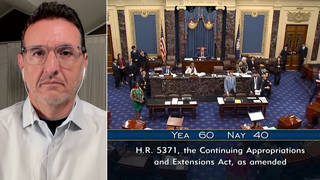
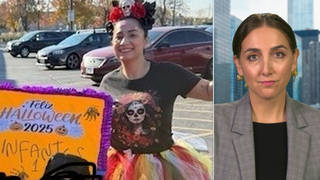
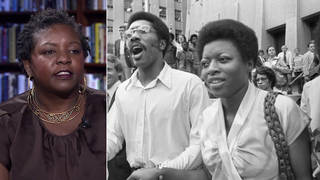
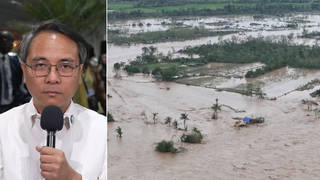
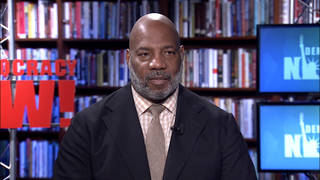
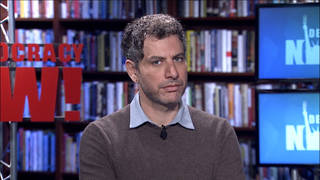
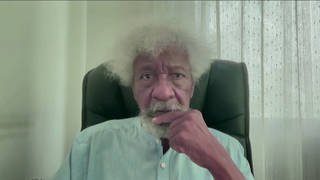
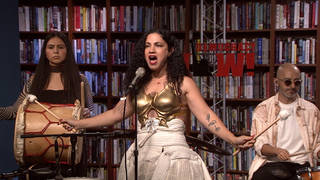
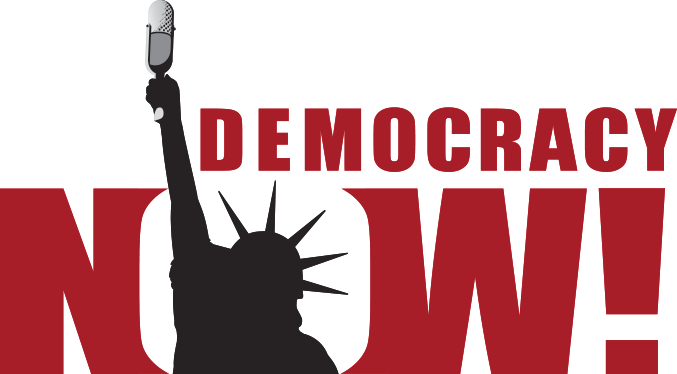
Media Options